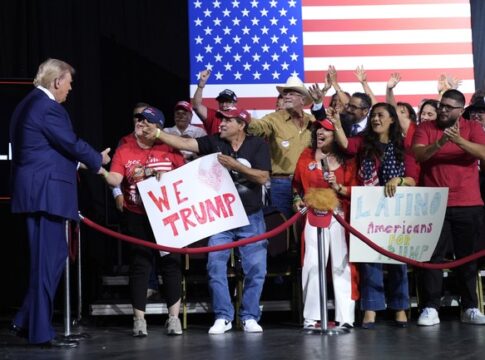From troubling election denialism to rampant misinformation about voter fraud, there are already multiple respects in which this year’s presidential election feels like 2020 déjà vu. Recently, another vestige of the 2020 election has begun to rear its ugly head: the so-called “independent state legislature” theory. In 2020 the ISLT posed a major threat to our democracy, as its proponents tried to use the premise to allow state legislatures to overturn the will of the voters in decisive Electoral College states. Fortunately, they were unsuccessful. Now the Supreme Court is being asked to hear another case about the scope of the ISLT.
Put simply, ISLT posits that because the elections and electors clauses of the U.S. Constitution empower state legislatures to regulate congressional elections and appoint presidential electors, state legislatures’ authority over federal elections is exclusive and absolute. Therefore, according to ISLT, state courts lack the power to review state laws implicating federal elections under state constitutions. Under ISLT, state legislatures would have unprecedented, unreviewable power over elections, even if state courts determine that their actions violate state constitutional provisions.
Last year, the Supreme Court resoundingly rejected ISLT and its essential premises in Moore v. Harper. Moore held that the elections clause does not divest state courts of their long-standing power to exercise judicial review over state laws. The court emphasized that state legislatures are “creatures” of their state constitutions and, accordingly, are subject to the “ordinary constraints on lawmaking” contained in those constitutions, as enforced by state courts.
The court did, however, issue a caveat. Moore noted that because the elections clause’s specification of state legislatures is “a deliberate choice that [the] Court must respect,” SCOTUS has an obligation to ensure that state courts do not evade the U.S. Constitution. The high court explained that under the elections clause, “state courts may not transgress the ordinary bounds of judicial review such that they arrogate to themselves the power vested in state legislatures to regulate federal elections.”
As several scholars predicted, ISLT proponents have now seized on the language in Moore to argue that state supreme court decisions that invalidate state election laws on state constitutional grounds violate the elections clause. This spring, the Montana Supreme Court held that various election laws, such as the elimination of same-day voter registration and the restriction of third-party absentee ballot collection activities, violated the right to vote in the state constitution. Now Montana has asked the U.S. Supreme Court to review and reverse that decision, arguing that by striking down these laws, the state Supreme Court unconstitutionally interfered with the authority of the Legislature.
Far from raising substantial questions under the elections clause, the Montana case underscores why the vast majority of post-Moore ISLT claims should not succeed. As I and others argue in an article forthcoming in Boston College Law Review, it will be exceptionally rare for a state court to exceed the ordinary bounds of judicial review, and accordingly, it will almost never be appropriate for the Supreme Court to second-guess state court decisions on state constitutional law under the elections clause.
In Moore, the court grounded its authority to review state court decisions under the elections clause in a group of cases that all stand for a simple proposition: Although the court ordinarily does not have the power to review state court decisions on state law, it can review these decisions if it is necessary to prevent state courts from evading a clear federal interest. The Moore court defined the federal interest underlying the elections clause as state courts not “transgress[ing] the ordinary bounds of judicial review such that they arrogate to themselves the power vested in state legislatures to regulate federal elections.” Only if a state court exceeds those bounds can SCOTUS step in to review the state-law ruling. Whether the court can review those decisions, then, turns on the scope of “the ordinary bounds of judicial review.”
As it turns out, the ordinary bounds of judicial review are exceptionally broad, as Moore’s reasoning, constitutional history, and fundamental principles of state sovereignty make clear. Moore underscored that, since the founding, state courts have conducted judicial review and state constitutions have regulated federal elections. Any Supreme Court review under the elections clause cannot disrupt state courts’ long-standing role of enforcing state constitutions against state laws.
Nothing in the drafting or ratification history of the elections and electors clauses suggests that the Framers intended to give state legislatures the ultimate authority over elections. In fact, the opposite is true: The Framers worried that giving state legislatures exclusive power over elections would allow them to subvert federal elections, so the elections clause was drafted to empower Congress to regulate the time, place, and manner of those elections as well.
And finally, the Constitution’s respect for states as separate sovereigns is a foundational principle in our federalist government, and this deeply rooted commitment supports a broad understanding of the ordinary bounds of judicial review. States are under no obligation to model their governments, including their judicial systems, on the federal government. What constitutes appropriate judicial review, then, must include the variety of adjudication philosophies and interpretive methodologies that state courts use to enforce their state constitutions, even if they’re different from those used by federal courts.
Taking these points together, it becomes clear that the ordinary bounds of judicial review are capacious, and it would be extraordinarily rare for a state court to transgress them. Indeed, the Montana Supreme Court decision exemplifies this. To reach its ruling, that court reviewed the state’s constitutional history, reasoned through its precedents, and faithfully applied the Montana Constitution’s commitment to voting rights to the state laws at issue. In other words, the Montana Supreme Court did what courts typically do. Its decision plainly falls within the ordinary bounds of judicial review.
As the election draws closer, opponents of voting rights will attempt to use ISLT to defy state court decisions striking down unconstitutional laws. But if the Supreme Court hears these claims, it should swiftly reject them as unfounded attempts to expand Moore beyond its clear terms and upend centuries of black-letter law upholding states’ rights to enforce their own constitutions, including protections for the right to vote.




